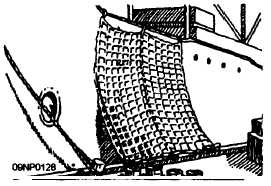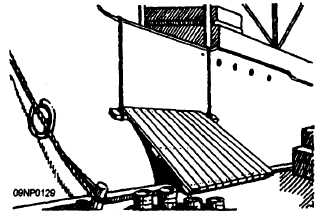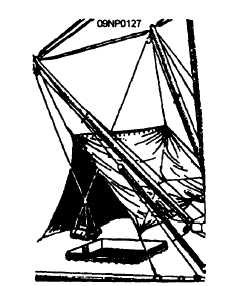| |
use on truck and reefer floors. The 24 wheels in the
central portion (figure 13-27C) are placed slightly lower
than the wheels at the ends. The wheels at the ends are
held in position by springs, which allow them to move
on their axles as the load is guided to its destination. The
difference in height of the center and end wheels permits
a certain amount of recking motion which aids in
movement and guidance of the pallet load. That is, the
tilting effect allows the dolly to turn, and the center
wheels (on offset axles) prevent loading of wheels in
slatted floors.
MATERIALS HANDLING ABOARD
SHIP
The use of materials-handling equipment aboard
ship is dependent upon several factors: type of ship, its
physical characteristics, and quantity of material to be
moved.
On cargo ships, the primary method of moving
material is by cargo booms. These booms may be
rigged to provide the required lift capability and to reach
the required work area. The most common rig is the
“yard and stay” which uses two booms and two winches
with the two wire ropes (whips) corrected to a single
cargo hook. In loading from or to a pier, one boom is
positioned over the hold and the other rigged out so that
the head of the boom is over the pier. The load may then
be picked up on one boom, transferred to the second by
taking in on the second whip while paying out the first
whip, and lowered from the second boom.
Figure 13-28 shows a yard and stay rig with a
suspended load. Also shown is one type of hatch tent.
Figure 13-28.-Cargo booms with Seattle hatch tent.
The Seattle hatch tent may be used to protect personnel
and cargo in the hold during inclement weather. A hatch
tent provides protection not only from rain or snow but
also from the sun during very hot weather.
A save-all is a device used to prevent the loss of
cargo overboard during loading or discharging
operations. The most common type of save-all,
(shown in figure 13-29) is a net (rope or nylon)
approximately 15 by 20 feet or larger. Wire rope nets
and wooden platforms (figure 13-30) may also serve
as save-alls. There should be a save-all rigged to each
working hatch, and also beneath each brow, skid, or
conveyor if the ship is loading or discharging through
sideports.
You can rig a save-all by lashing one side of a net
even with the bulwark. Then by securing it to cleats on
the deck or bulwark, and securing the bottom of the net
to the stringer on the pier. Leave enough slack in the
save-all to allow for the rise and fall of the tide.
A save-all may be improvised by lashing together
several cargo nets.
When working light cargo, a
tarpaulin may serve as a suitable substitute.
Figure 13-29.—Rope save-all.
Figure 13-30.— Wooden save-all.
13-13
|



